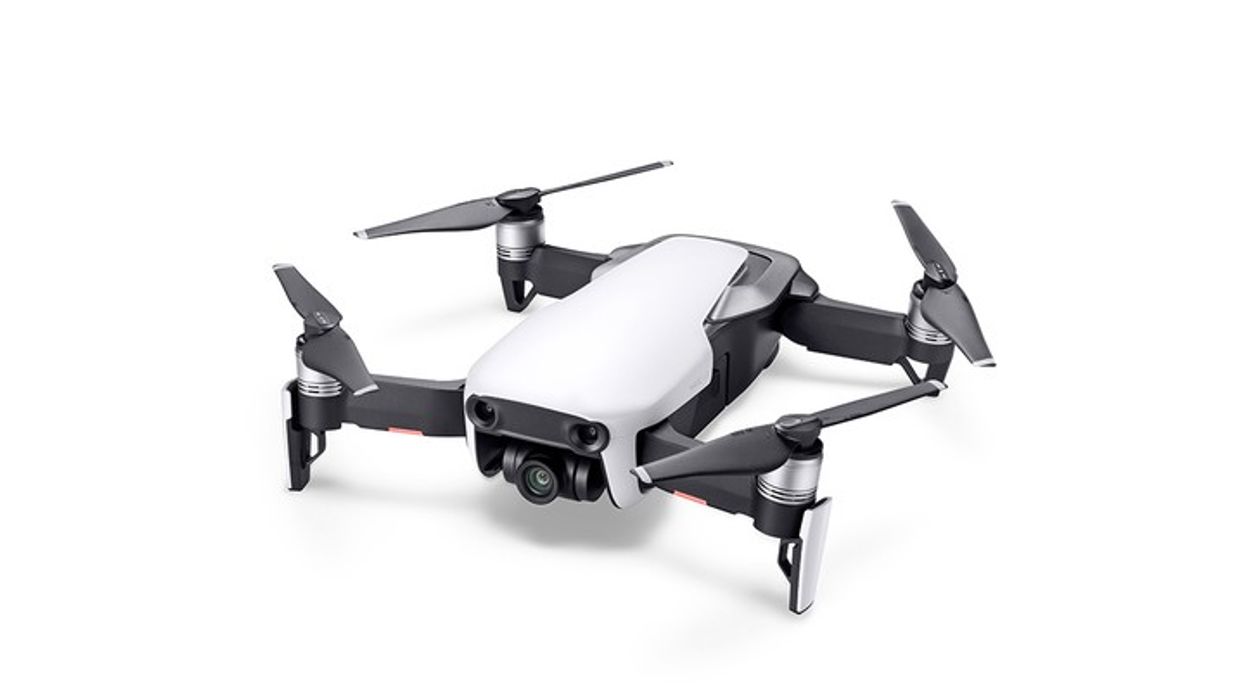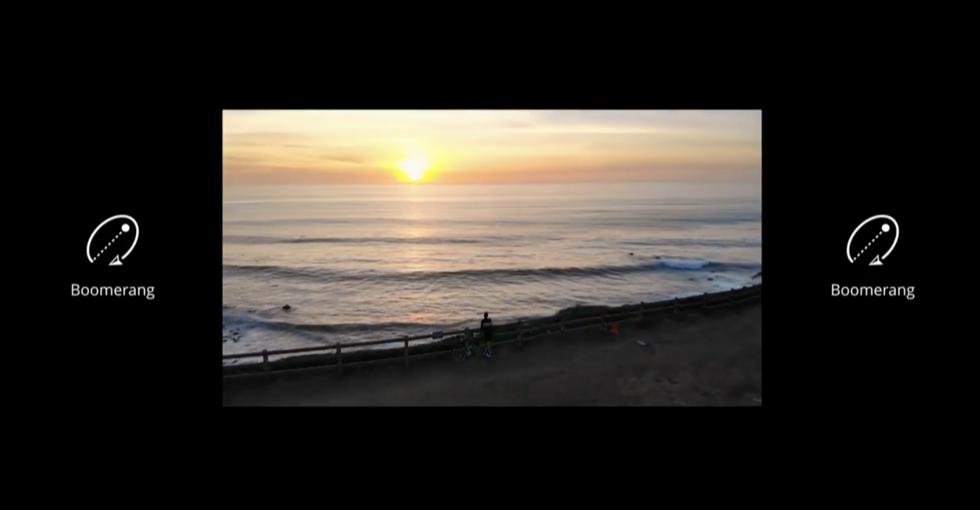Good Things Come in Small Packages: DJI Releases Foldable, Portable Mavic Air Drone
DJI has created a brand new class of drone.

It seems, lately, DJI is trending downward in size but not quality. Over the past 18 months, the company has iterated its technology and released new products at an incredibly rapid pace. It began with its release of the Mavic Pro about a year and a half ago, making it easy for people to bring a 4K drone with them wherever they go, thanks to its foldable design and small chassis. After that, DJI debuted the Phantom 4 Pro, which boasts advanced obstacle avoidance sensors and professional quality imaging and is designed for creative professionals. Since then, DJI has released its smallest drone, the Spark, which features gesture control, and can automatically take complex shots at the tap of a button; the world’s first 6K Super 35mm drone-optimized cinema camera, the Zenmuse X7; and today, No Film School was in attendance when DJI released its most portable 4K drone to date, the Mavic Air.
About the half the size of the Mavic Pro, the Mavic Air also features twice the resolution of the Spark, allowing it to slot in very nicely between the two ultra-portable models. But the Mavic Air’s size is only part of the story. DJI’s latest creation also has some new and improved features designed to redesign on-the-fly creativity.
Enhanced portability
Mavic Air features an incredibly small form factor. As mentioned above, Mavic Air is only half the size of the Mavic Pro, weighs 41% less and yet it carries a high quality camera and lots of image processing and computing power on board. In order to do that, DJI streamlined Mavic Air's design and created a new ventilation system that pulls air through the drone and keeps it from overheating. Borrowing from Mavic Pro's design, Mavic Air's legs fold up and allow it to easily fit into your pocket. A new folding landing gear design makes the drone even more portable and assists with antenna reception (described in greater detail below).
4K 3-axis stabilized camera gimbal
A first for a drone its size, the Mavic Air features a 4K camera that is stabilized on a 3-axis gimbal. The chassis design is such that it encloses and protects the gimbal while in flight and in transport, allowing for more precise camera movements. To help further reduce camera shake, the gimbal utilizes supplemental vibration reduction for extremely steady shots.
The camera on the Mavic Air utilizes a 1/2.3" CMOS sensor. Larger pixels on the sensor mean that it it is more sensitive to light and, therefore, more efficient and better in low-light conditions. Mavic Air is able to capture 12MP stills in Adobe DNG RAW and, 3-axis stabilized, 4K resolution video at up to 30fps. For slow-motion shooting, Mavic Air can capture 1080p video at 120fps. Unlike most 4K cameras of this size, Mavic Air is capable of recording at 100Mbps in h.264, providing even higher quality video files while keeping file sizes manageable. The camera also features a wide angle 24mm f/2.8 lens.
Advanced Pilot Assistance System (APAS)
DJI set out to create a drone that would "empower everyone to create without limits." Part of that means creating a drone that can be flown easily and safely. In keeping with that goal, the obstacle avoidance system featured on the Mavic Air has been in the works since the release of the Mavic Pro according to DJI. Mavic Air features a re-designed, 7-sensor obstacle avoidance system that features dual forward, downward, and rear-sensing cameras, allowing it to fly safely forward and backward. This new system not only adds rear-sensing obstacle avoidance, but leverages all seven diverse obstacle sensing cameras, and gives Mavic Air the ability to plot courses above and around perceived obstacles even while you're flying manually (as opposed to when flying in an autonomous mode). Instead of your drone just stopping and hovering when it senses an obstacle in flight, if finds a way around it. This new system is called FlightAutonomy 2.0 and uses new algorithms and sensors to create a 3D map of its immediate environment that allows Mavic Air to safely self-navigate even in environments when it doesn't have access to GPS.
APAS synthesizes information gathered through FlightAutonomy 2.0 with real-time input from the remote control to create an assisted flight experience that is safe and reliable meaning that virtually anyone can safely fly whether they're indoors at home or out hiking in the woods.
No Film School had the opportunity to get some stick time with the Mavic Air in an obstacle course that DJI had set up and it worked well. The drone detected and avoided various obstacles in its way as it flew constantly forward. Because this mode relies on light sensing, moving obstacles (like people) and rapidly changing light conditions can fool the sensors. However, piloting the drone slowly and consistently even in the indoor obstacle course surrounded by onlookers worked as advertised and was impressive to watch.
New intelligent flight modes
The Mavic Air features all of DJI's currently available Intelligent flight modes and it has updated versions of ActiveTrack and Quick Shot modes. ActiveTrack allows you to track an object (or yourself) automatically. Now, you just need to tap on the object that you want to track onscreen (no more drawing a box around it with your finger) and the precision with which ActiveTrack is able to follow and frame its subject has also been improved to reduce instances of subject loss and accommodate situations where the subject is changing speeds or its movements are irregular.

Asteroid & Boomerang QuickShot modes
The growing popularity of QuickShot modes led DJI to introduce two brand new ones: "Asteroid" and "Boomerang." Asteroid combines a spherical, 360-panoramic still photo with a 10-second video clip to create a unique and dramatic reveal shot of yourself. Boomerang flies a path up and away from you and then returns and creates a beautiful shot showing you in your surroundings. Both of these new modes work at the tap of a button, just like the existing QuickShot modes.
SmartCapture
Mavic Air has an updated set of gesture controls called SmartCapture that DJI claims is the "most responsive and intuitive way to capture images on the go." Simply by holding your palm facing the drone like some sort of Jedi maneuver, you can instruct Mavic Air to start its motors and take off. From there, you can control the distance between the drone and yourself. The obstacle avoidance sensors maintain a safe buffer distance between you and the drone and Mavic Air's rear-facing obstacle sensors make this mode even easier and safer to use. Gesture control has a maximum distance capped at 19 feet when using only your hands. When using your smartphone, that range increases to over 200 feet, and with the included remote control, you can control Mavic Air from up to 2.5 miles away.
Computational photography
Speaking of 360 photos, Mavic Air features an autonomous mode for taking immersive panoramic photos at the tap of a button that DJI referred to as “computational photography.” Mavic Air will take all of the necessary photos for your panorama, automatically stitch them together into a single panorama and then save the final image to the camera roll on your smart device so that you can share your photo instantly. The entire process supposedly takes about a minute.
HDR photography
Mavic Air features an HDR mode for still photography designed to allow you to capture detailed images even in tricky lighting conditions (like shooting on a bright sunny day with dark shadow areas on the ground). HDR mode automatically sets exposure settings to preserve details in both the shadows and in the highlights so that you can get the most out of your image without spending time worrying about your exposure settings.
8GB internal storage
In case you've forgotten or misplaced your micro SD card or you've run out of space, Mavic Air has 8GB of on-board memory to help ensure you never miss a shot. The onboard USB-C port allows for fast and easy transfer of your shots from the drone to your computer (or portable backup device like the DJI Copilot).
New antenna design
Hidden within the foldable landing gear is a brand new omni-directional antenna. DJI claims that moving the antenna away from the body helps increase the control range. This design, paired with a dual-band wifi system, gives Mavic Air a control range of up to 2.5 miles.
Pricing and availability
Mavic Air is available in Arctic White, Onyx Black, and Flame Red, starting at $799. The Standard Package includes the Mavic Air, the remote control, protective case, and propeller guards. The "FlyMore" bundle includes all of that, an extra set of propellers, two extra batteries, a four-battery charging hub, and a car charger for $999. Shipping and in-store availability begin on January 28, 2018.
Tech Specs:
Dimensions
- (Folded): 168x83x49mm (LxWxH)
- (Unfolded): 168x184 x64mm (LxWxH)
Camera
- 1/2.3” CMOS
- Effective Pixels: 12 MP
- Video ISO Range:
- 100 - 1600 (auto)
- 100 - 1600 (manual)
- Photo ISO Range:
- 100 - 1600 (auto)
- 100 - 3200 (manual)
Still Photography Modes:
- Single shot
- HDR
- Burst shooting: 3/5/7 frames
- Auto Exposure Bracketing (AEB): 3/5 bracketed frames at 0.7EV Bias
- Interval: 2/3/5/7/10/15/20/30/60s
Still Image Size:
- 4:3 4056x3040
- 16:9 4056 x 2280
Video Resolution
- 4K Ultra HD: 3840×2160 24/25/30p
- 2.7K: 2720×1530 24/25/30/48/50/60p
- FHD: 1920×1080 24/25/30/48/50/60/120p
- HD: 1280×720 24/25/30/48/50/60/120p
Watch the live stream
Didn't get to see the live stream or catch the live event? Watch the official release video below.
Source: DJI












